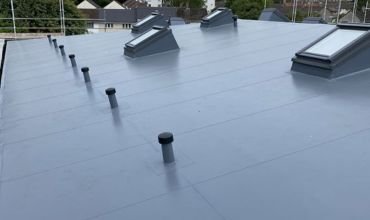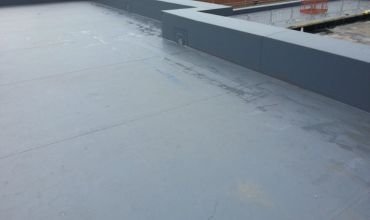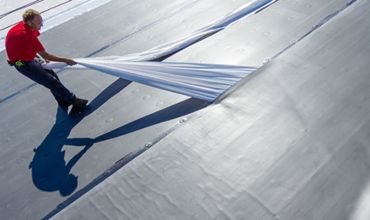Maintaining your roof is an integral process that prevents it from getting damaged and makes it long-lasting. If you feel that your roof needs repair and you want to go ahead with single-ply roofing, this guide covers all the details that you need to know.
No matter if you want to rebuild the roof of your residence or business, you will find the single-ply roof a lot beneficial. Furthermore, learn the different types of membranes that are used in this process and gain complete knowledge about the technique. Ensure to connect with our professionals who are highly skilled and offer wonderful services.
When is the high time to Replace Your Roof?

- You will notice damages in your roof, similar to splintered and deteriorated shingles.
- You are continuously facing the problem of water leakage through your roof.
- There might be some structural problems that arise due to severe weather conditions
- It is imperative that your roof undergoes regular repairs.
- If the condition of your roof is deteriorating, this indicates that it’s approaching its final days.
Why should one choose Single-ply roofing?
If you do not know when it is the right time to replace your roof, here are some useful suggestions. If you can connect with the points below, then it is high time to get your roof repaired.
A single-ply roofing solution consists of a single layer of material. It is primarily used for low-slope roofs and is widely appreciated for its lightweight design and resilience. Unlike asphaltic rolled roofing systems, single-ply roofs have a reduced number of seams and do not require the use of hazardous torches or hot asphalt for their installation. Additionally, they come with prefabricated detailing accessories that enhance the ease of the installation process. There are three types of single-ply roofing systems, which are mentioned below.
Types of Single Ply Roofing

A single-ply roof system is characterized by the use of flexible sheets crafted from thermoset or thermoplastic membranes. Each type of membrane has its own benefits. For example, thermoplastics are particularly advantageous due to their capacity for repeated melting and reuse, whereas thermosets retain a solid structure after the curing process. Here are the three principal types of compounds utilized in single-ply membranes.
1- Ethylene propylene diene terpolymer (EPDM)
EPDM is a type of synthetic rubber and is made from two key components: ethylene and propylene, which are obtained from oil and natural gas. The roofing membranes produced from EPDM are offered in substantial rolls, predominantly in black or white. Roof systems that utilize EPDM generally have a lifespan ranging from 10 to 25 years.
Advantages of the EPDM roofing system

There are many benefits of installing EPDM single-ply roofing, which are discussed below.
- It is very flexible in low-temperature environments, i.e. cold-weather regions.
- It serves as a defense against hail and abrasion.
- It provides shielding from ultraviolet radiation.
- The adaptable membrane allows for more convenient installation, particularly at flashings and penetrations.
- These are available at remarkably low prices.
- It is well-suited for extremely cold climates.
2- Polyvinyl chloride or polymerized vinyl chloride (PVC)
PVC is a synthetic thermoplastic polymer that offers numerous advantageous properties, including resistance to fire, wind, chemicals, and moisture. It can be installed through various methods, such as mechanical fastening, ballasting, full adhesion, and seam welding.
The durability of a PVC roofing system installation is estimated to last between 15 and 30 years. As compared to EPDM, these are generally easier to install due to their smaller roll packaging, making them particularly well-suited for both smaller corporate and domestic installations.
Advantages of the PVC roofing system
Installation of PVC single-ply membrane roofing offers several advantages.
- A reflective surface that enhances energy efficiency.
- It is highly resistant to wind, moisture, and various chemicals.
- It comes with remarkable strength and is capable of withstanding up to 350 pounds per square inch in breaking strength.
- It has long-lasting durability resulting from the welding of seams instead of relying on tapes or liquid adhesives.
- Versatile applications, suitable for patios, decks, and balconies, especially when enhanced with a non-slip coating.
3- Thermoplastic polyolefin (TPO)

Thermoplastic polyolefin single-ply roofing is gaining popularity within the commercial industry. These systems utilize a single layer of synthetic thermoplastic reinforced with scrim to create a naturally reflective surface that offers resistance to UV radiation and wear.
The expected lifespan of a TPO membrane roofing system ranges from 7 to 20 years and has a similar roll size to TPO and EPDM roofing systems.
Advantages of the TPO roofing system
The advantages of the TPO roofing system are listed below.
- It provides excellent resistance to wind and is offered at a low cost.
- This reflexive surface is ideal for minimizing the damage and exposure caused by UV radiation.
- The durability is attributed to the presence of welded seams, which contribute to its longevity.
- It has great strength, three to four times greater than that of EPDM, though it falls short of PVC strength.
Why should you choose ManageMyRoof for your needs?
Your roof protects you against a myriad of external influences. We vow to preserve it and offer services that guarantee its enduring quality. Here are compelling reasons to engage with us.
- ManageMyRoof is home to specialists who possess years of expertise in the installation of roofs, accommodating various styles and materials.
- We utilize the best roofing substances from our most reliable suppliers.
- Our team members are committed to working meticulously, ensuring that the installation process is completed while maintaining the highest standards of quality and preserving the integrity of the job site.
- Each roof we install is customized to meet your specific requirements, preferences, and financial considerations.
Process of our Roof Installation

When you choose us for Roof Installation for your single-ply membrane roof, you can expect a streamlined and professional process designed to meet the requirements of both residential and commercial projects.
1- Our team will start with an in-depth analysis of your roof’s condition, following which they will dicsuss with you about your requirements and preferences.
2—Our experts will create a personalized installation plan, considering factors such as architectural style, local climate, and budgetary requirements.
3—We offer top-quality roofing materials that guarantee stability, allowing you to select the best option for your roof.
4- Our team carefully prepares your property, ensuring that the external features around the roof are cleaned and protected.
5—If necessary, we will carefully eliminate your existing roofing materials, leaving a pristine area for the new roof.
6—Our team will perform a detailed inspection of your roof deck and carry out any essential repairs to establish a strong foundation for the new roofing.
7—We will also select the best water-resistant underlayment to ensure the correct installation of flashing, avert leaks, and mitigate future damage.
8- Our skilled professional will install your new roofing system with much care and precision.
9- We will give the ongoing work a final inspection, ensuring that all aspects align with our elevated standards.
10 – As we approach the completion of our tasks, we ensure a comprehensive cleaning of your property, confirming that everything is well-organized and tidy by removing all remnants from the job site.
Factors that Determine the cost of roof installation

We, ManageMyRoof, do not have a fixed price for our services. Our charges depend on the following factors of the roof-
- Dimensions
- Layout
- Type
- Destruction
- Accessibility
- Professional Charges
- Demolition Preparation
Final Thoughts
You are now well-equipped with details about single-ply roofing and its varieties. So, choose the one that best fits your needs and contact us as soon as possible. We are a team of dedicated staff who work tirelessly to provide the best services to our customers.
People may also ask
The composition of single-ply roofing systems includes flexible sheets crafted from thermoset or thermoplastic membranes, with each type presenting its own set of advantages.
If you feel your roof is damaged or there is water leakage, it is high time to consider installing a new one.
These membranes possess exceptional durability and have a life expectancy of 25- 40 years, aligning with the overall service life of the structure.
Generally, single-ply membranes are designed to handle occasional light foot traffic. However, their smooth finish can result in a slippery surface under wet and cold conditions.
To install a new roof, contact ManageMyRoof. Our professionals are highly skilled in their craft and will definitely make your roof amazing.
A single-ply membrane is generally 1.1mm to +2mm thick, but it still is a complete roof system.
A single-ply membrane has a long life span and offers a high level of insulation, which will decrease the building’s heating and cooling costs.
The most common single-ply material in the market these days is TPO, as these are the least expensive.


Leave a Reply